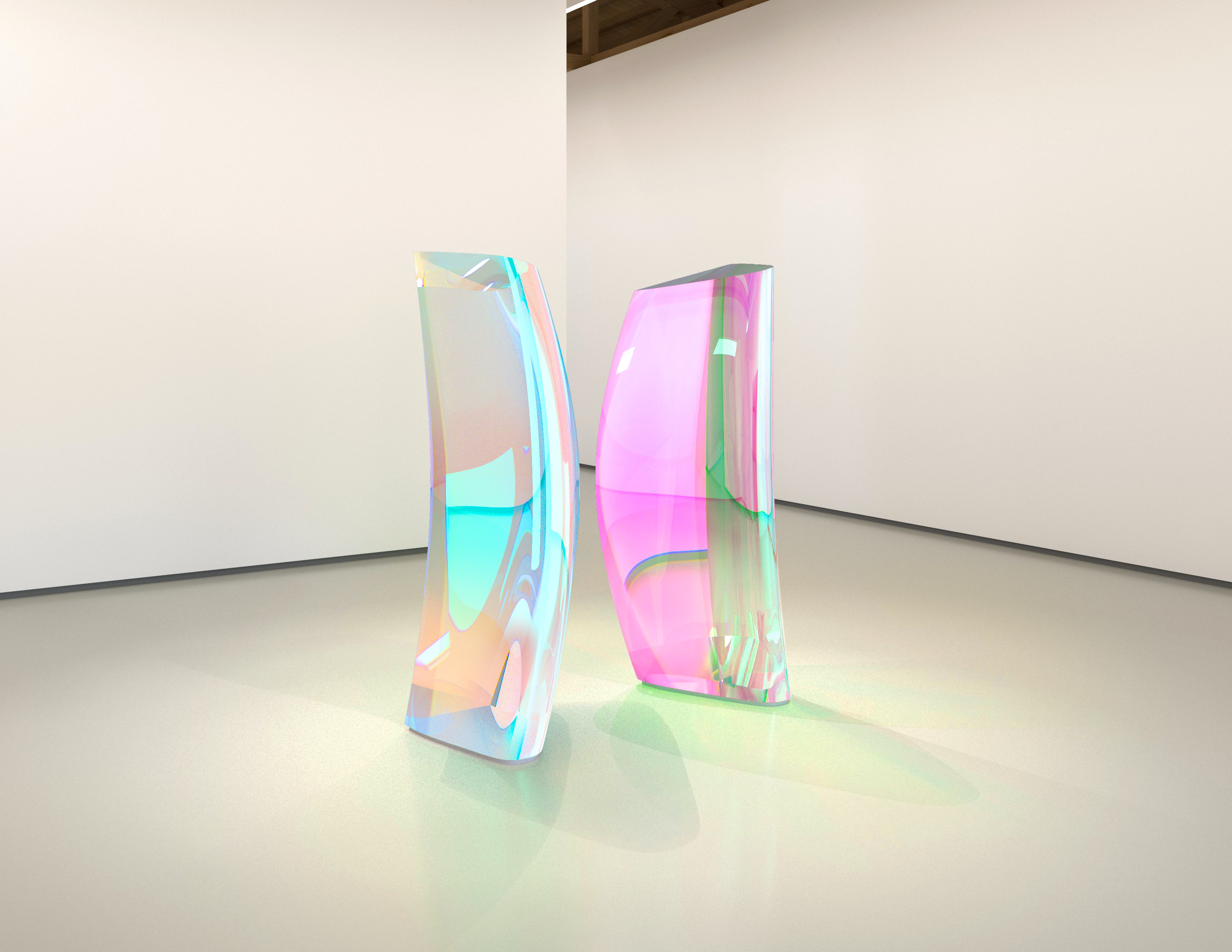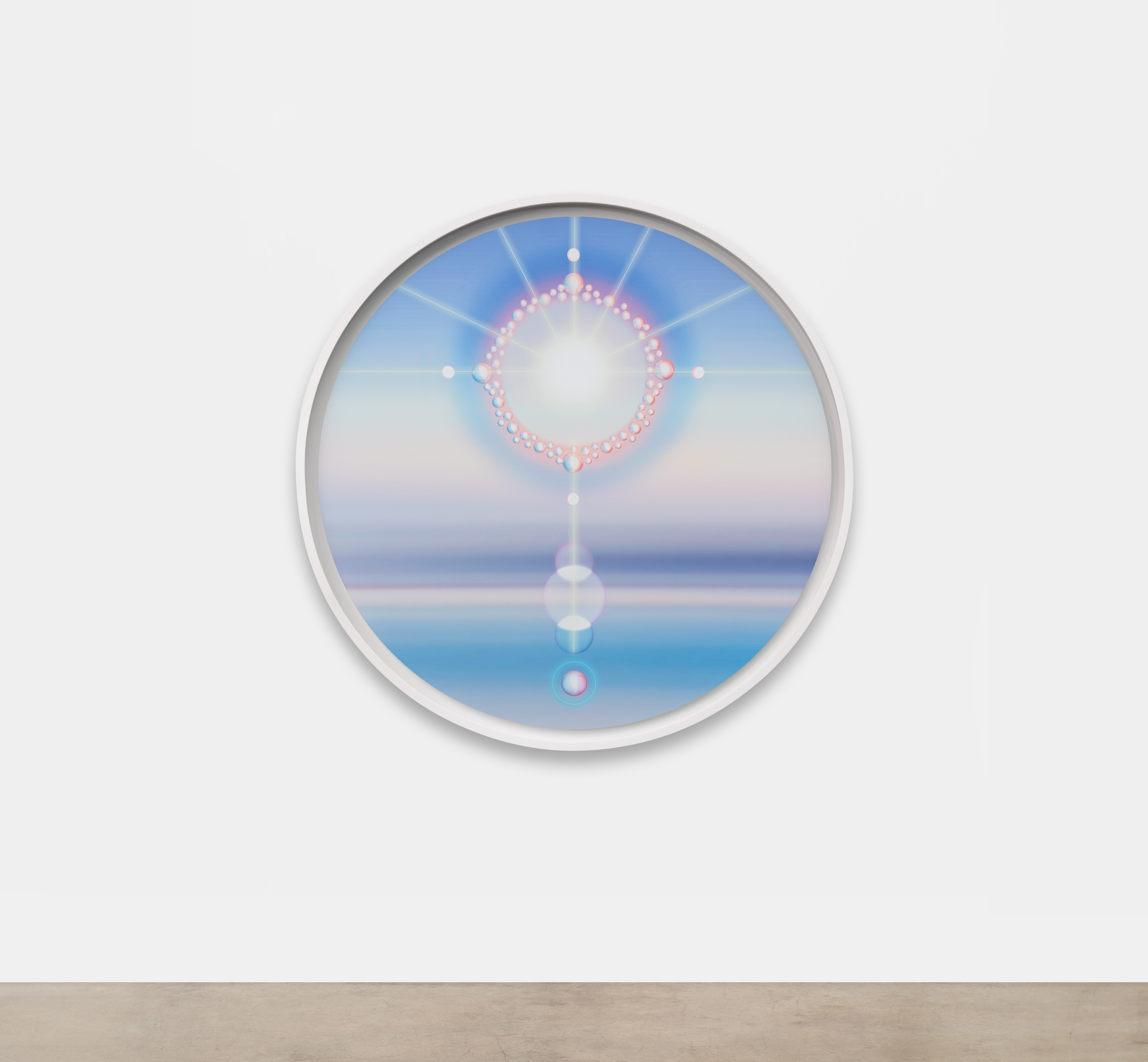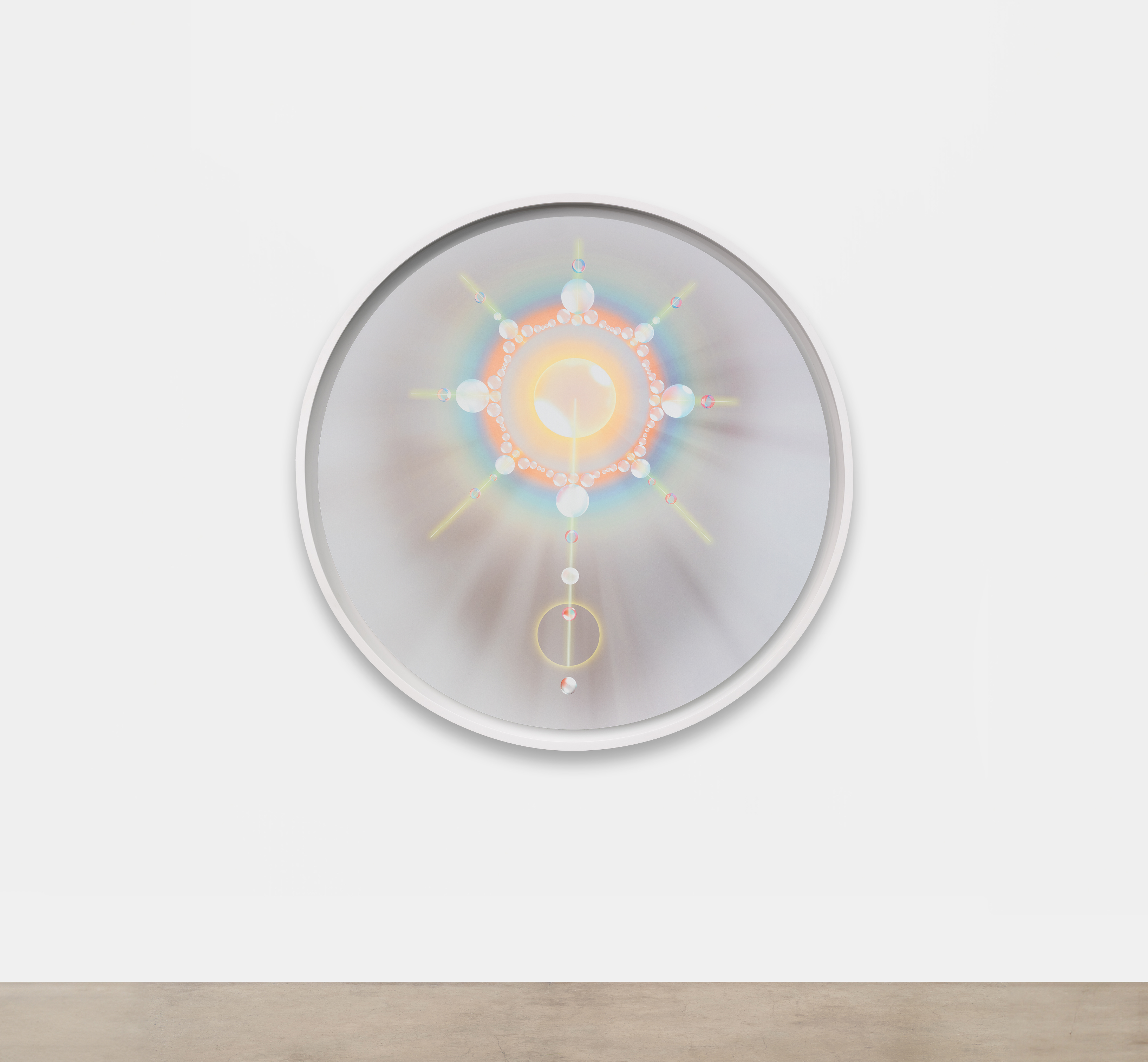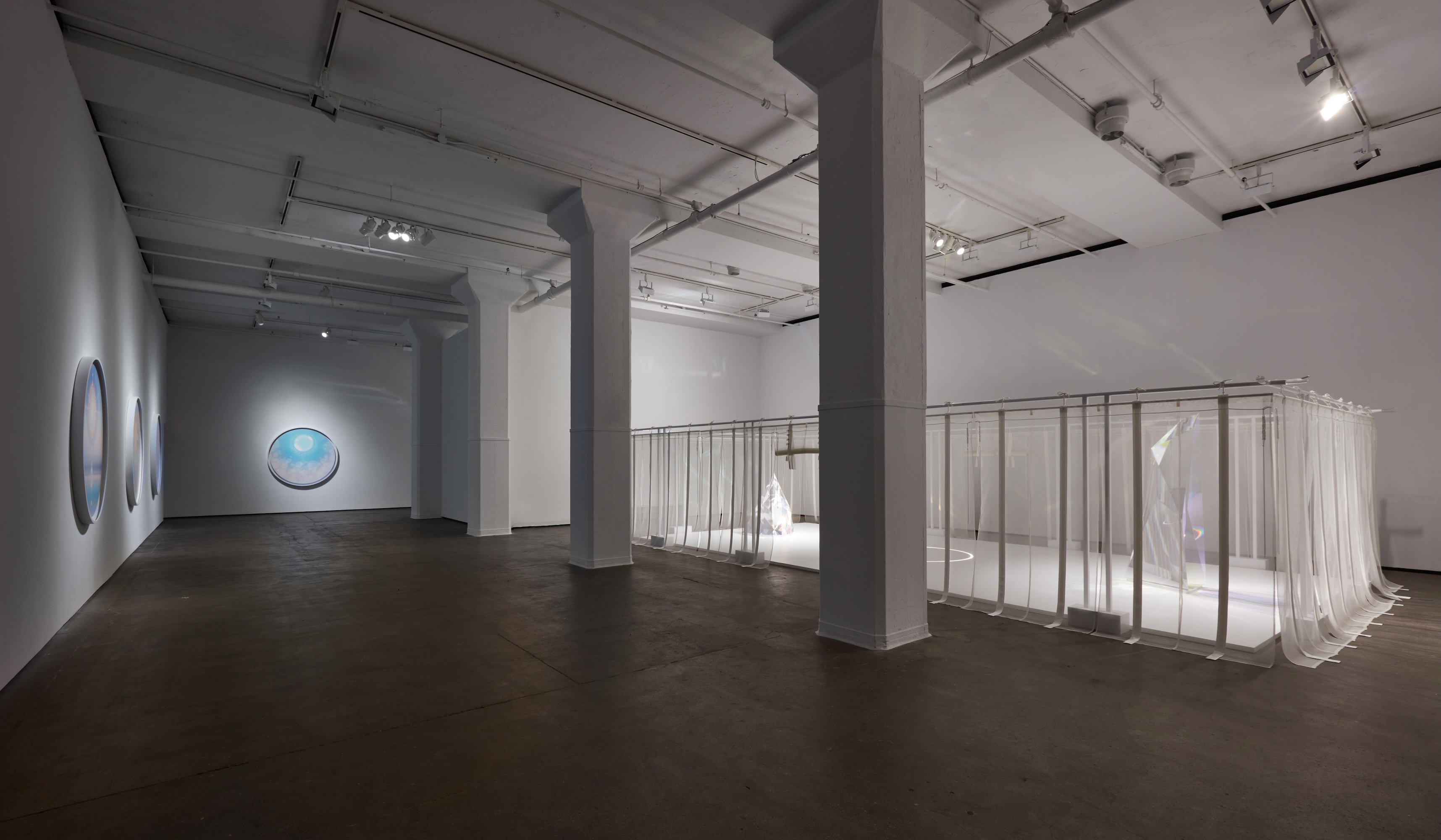F L A U N T


Clothed entirely in white, Japanese artist Mariko Mori makes her way slowly through the Sean Kelly Chelsea gallery bearing two beaded pendants. At one end of a large room, the enclosure contains two opposing crystalline shapes (Kamitate Stone I, 2025 & Oshito Stone III, 2025) which hold a diachronic surface that is conditionally transparent. Pausing to remove her shoes, she places the beads on a raised platform at the entrance of a silken cloth enclosure. There is a careful breeze that blows through the windowless room, fluttering through the translucent cloth. Entering the center of the space, she begins to recite a passage from the Kojiki, or the Record of Ancient Matters, said to be written by Ō no Yasumaro at the request of 8th-century Empress Gemmei. Here, she presents Radiance, an exhibition of new work on view at Sean Kelly New York through December 20.

Roughly translated, the passage spoken by Mori begins with the inception of heaven and earth. A story of Japanese creation centered on the divine union of Izanagi and Izanami, it’s a myth that has found itself ingrained in the practice of Shinto petroforms found throughout Japanese classical temple traditions. Much like her earlier reconstructions in Dream Temple (1997-1999), which was a metal, glass, plastic, and fiber-optic recreation of the 739 AD Horuji Yumedono, the artist pays tribute to the symbolism and motifs in Japanese spirituality and temple traditions dating back to prehistoric Jomon customs. The idea behind iwakura, or the use of these petroforms in Japan, goes back to a Jomon principle of animism, or nature worship.
Elsewhere in the exhibition, you can find the two identical pillars of Love II, a more literal representation of Izanagi and Izanami. The two rocks, which make up a subtype of Iwakura called Meoto Iwa (or marriage rock), are often featured together, bound by proximity or by braided straw shimenawa ropes.

Rock forms, in particular, as Mori notes in our conversation, have been at the forefront in her latest exploration in an almost post-humanist humanist way; connecting ethnological representations of nature in spirituality from Ireland to England to the Nordic countries to the north. One of the most notable examples of this tradition in Japanese culture is the formation of Onogoroshima, where it was rumored that the divine couple, Izanagi and Izanami, churned the primeval sea with the heavenly spear Amenonuhoko from their vantage point on the floating bridge of heaven. Upon retrieval, the water that had dropped from the spear formed the mythical island of Onogoro. Inspired by such legend, her 2024 exhibition with Scai the Bathouse was aptly named Kojiki and featured a recreation of such mythos.

Having always been an ardent historian and frequent admirer of figurative tradition maintained throughout centuries, the roots of Mori’s studies are shrewd in conception. It’s a common theme throughout the artist’s work, even in origin, when Mariko Mori first broke onto the international art scene with her large-format self-portrait photography in the mid-1990s. The beginning of Mariko Mori’s profession was marked by her landmark explorations of a techno-emmeshed future. It’s only appropriate that, through the course of her career, she makes her way back to the other side. It seems at times, the further we wade into these uncharted waters of artificial intelligence and automation, the farther we get from the shoreline of humanity.
In her current works, the artist has extended her practice to more philosophical inquiries. Her closet, for instance, is made up entirely of white and off-white fabrics. Following a transformative event in 1998 in which she was faced with “a blinding bright white light,” she has since searched for that in her choice of clothing. The fabric that is closest to light, symbolic of her quest for purity and ego-free transcendence. It’s a meditation in greater spiritual connection, oneness of all living creatures on Earth, and peace–something I found aptly represented in her Unity series hanging on the walls. With each circular painting holding a sphere of undefined material (solid, gaseous, liquid?) that reflects in on itself in a Drostian effect to infinity, it was a frenetic, but organized composition that felt peaceful to look at.
Below, the artists speaks about her journey since her early photographic projects, to her teachings in Buddhism, the past-future, and the Japanese Kojiki record.

Can you share a brief overview of your journey in the art space?
My early work was quite focused on social criticism and making a statement on artificial reality. While I was traveling around the world to photograph the backdrop of the photographic work, I was able to visit places like Arizona, the Red Sea, Tulufan–these places that have vast nature, and it really had a great impact on me because I had only lived in a city all my life, like Tokyo, London, New York.
It was really my first experience to encounter the power of nature…kind of a mind-opening experience. Around the same time, the image that I wanted to produce was taking Buddhist iconography and introducing Buddhist philosophy, such as esoteric Buddhism. So at the same time, I was studying Buddhist philosophy. So [my artistry] came as a combination of contemplating on deeper consciousness and also kind of trying to really understand the meaning of enlightenment. My realizations through the process of making that artwork gave me a great impact to shift my focus from a very social commentary to exploring the best philosophies through my work.
Do you still think about the future in that way, in comparison to these larger philosophical interactions with nature?
I think that modern society, compared to–actually, I always look at the historical meaning in the past. I would say in my past 20 years, my interest was really focused on prehistoric culture, a culture that still has a great sensibility to nature, I would say. Looking at the culture from our ancestors, which is very deeply rooted in nature. The reason why I decided to focus on that period is because we are disconnected with nature. I believe that's one of the main reasons that we actually know the direction that we are in. We all know that we are witnessing this separation between human and nature. We created a great issue that we need to overcome. We also know that by now, if we continue to keep the society running in this way, there's no nature for the future generation. We are still able to see the pristine nature on the earth, but it is actually in a fragile state. One thing that I know from living in this world is that when you envision reality, it can be changed. So I think that the reality that we are in now is inherited from the generation before.
The responsibility of this reality that we have is how we envision the future. I feel like that means actually it's quite positive, because if we envision the future as society taking a balance with nature, or at least honoring nature, or at least being more sensitive to nature, the reality will change. So I believe in that, therefore, I started to produce work to honor nature.
In terms of how we must realize the power of our spirituality…modern society may have underestimated our power of spirituality because I feel that's the key to envisioning the appropriate future vision.

There are a lot of Eastern words that relate to spirituality that are difficult to translate into Western ideas. Do you find that to be a block in explaining your work to Western audiences? Do you think that there's often a difference in the reception of these ideas?
I think Daisetsu Teitaro Suzuki did a great job of explaining Zen Buddhism to the West. Many artists from the 70s have acknowledged the Zen philosophy or Buddhist philosophy and expressed that very deeply in their work, very successfully. I think that it’s maybe not as challenging because our audience is quite knowledgeable about Eastern philosophy.
Probably the sensibility might be a little bit difficult to translate. So for example, how I see in Japanese culture–the very core, even from the Jomun, even to the Ayaoi or Kofun Nara or Heian or Kamakura Muramach, Muyamaya–there is a seamless core that is never…that thing that's been passed down continuously, uninterrupted, that's been carried on all this time... that feeling towards nature…well, how should I put it? Well, the roots of reverence and then, passion, or maybe sensitivity, that's always been at the core.
So, Japan's attitude toward nature, with its incredibly rich seasons, the way it cherishes nature's beauty, the way it reflects its changing forms, the way it's reflected, is truly rich, and it still is today. That way of relating to it, that connection, has continued unbroken throughout history. It's truly at the root of the culture. The way it is perceived changes with each era, but it has always continued.
When Buddhism came to Japan from China and Korea, the way it's perceived is more like this permeating sense. Buddhism flows in and is accepted, and it's conceived within Japanese culture itself, nurtured within it. That's the history. So, China has its own Zen, and Korea has its own way of understanding Buddhism, but the expressions are quite different. For example, in Japan, if you look at Buddhist statues from the Heian period, they have very soft expressions. Then, well, by the Kamakura period, they become a bit more severe, but that's how it is. This is especially pronounced in the Heian period. Waka poetry, you know, like the Waka Poems, truly expresses emotions towards natural phenomena. That became the very foundation upon which this culture was built. So, trying to understand that in, say, America... America also has beautiful nature and various riches, but it's more dynamic. So, Japanese awareness of nature... That's a bit different.
Another thing is that Japan has truly experienced disasters—earthquakes, tsunamis, torrential rains. In that sense, humans live amidst a harsh nature, so there's this fear or dread of nature. We've experienced it firsthand, so in that sense too, Shinto plays a very important role. It's about appeasing the wrath of the Gods of nature or gaining their blessings. You know, when it rains in that sense, it was truly such a problem, so Shinto was very important as the foundation of daily life. And I think that aspect is quite difficult for Westerners to grasp, because their relationship with nature is a bit different. It's a nostalgic kind of relationship, and there's this profound reverence for nature. That part, I think, is perhaps unique to Japan.

You mentioned the temple culture around Japan, and I would love to go to the inspiration behind Radiance in Japan's stone cultures.
The stone culture began in the Jomun era, which is probably around 2000 BC, and was very strong in 1000 BC. It was really inherited through the Kofun period, and especially if it was much illustrated in Kojiki, which is the oldest written book of creation myth and mythology of Japan.
Basically, the story had some kind of stone, it's called Iwakura, which is like a landing stone. It's the landing stone of nature Gods or the stone itself, the nature Gods live within a stone or some mythological symbols on stone, which I did with some stone Onagoro, which were in mythology.
In mythology, there's an island called Onogoro that Izanagi and Izanami created at the very beginning of the world. There's also what Iwakura mentioned in the Kojiki stories.
So it's quite a long history and tradition of worshiping this stone. Even nowadays the worship of Iwakura exists in society. I was really inspired by this stone culture because it was everywhere in prehistoric cultures. In Scotland, Ireland, England, all over the Nordic countries, to France, and maybe we find it somewhere in Taiwan. However, I find it interesting that Japanese people kept this tradition until now and feel that it's like a symbol of the power of nature Gods and a way to connect with the nature Gods, meaning a way to honor nature. So I was very much excited to find this Iwakura stone all over Japan, and lots of them have unique styles and so on.
So my research began to visit all those Iwakura stones. From that research, I envisioned some stones deliberately from each site. One that is going to be in the exhibition is called Kamitate, which is exactly the stone that symbolizes the Creation myth of Izanagi and Izanami.
They’re always two together, either separated or completely together. There were many of them, maybe the people wishing for fertility, or maybe people wishing for hojo [means assistance & support but refers to a powerful historical family that ruled as regents]. The symbol of hojo, because it's male and female, maybe [refers to] fertility.
One of the works in the exhibition called “Love,” which was symbolizes this. So the couple has a couple stones. So that's the stone culture that I interpreted with the contemporary material.

Looking at your work from 1999 with Dream Temple, and in reconstructing spiritual spaces, has your understanding changed or developed within your exploration of spirituality?
The dream temple was really focused on one of the sutras which explains the “mind-only” in English. In Japanese, it’s called yuishikiron, and it's about deeper consciousness and the mechanism of reincarnation. And so the Ālaya-vijñāna consciousness is really explaining that in this sutra. My dream temple was really focused on the Ālaya-vijñāna consciousness and deeper consciousness. While I was producing this work, I really wanted to understand, truly, about Ālaya-vijñāna consciousness and deeper consciousness. In reading many books, I understood structurally and conceptually, but then I had this kind of a spiritual experience to encounter great light. And that experience really answered the part that I didn't 100% but gave me that answer.
I started to research Jomun etc, to really understand how prehistoric culture interpreted reincarnation. The Jomun had a reincarnation idea, meaning rebirth. The rebirth was really the term or concept that I found in prehistoric culture. I try to go back to earlier history to understand where we are from.
Through that process, I discovered many rituals, from Okinawan rituals to Shinto rituals to really try to decode what the ritual means and try to put the puzzle together. I continued to experience this great light, and I started to understand what the core of Buddhism Komyo means. So, I try to put that in my drawing, so the current drawings are really about this great light, which is my take of understanding wholeness and oneness.
We see everything as divided. Nature, human, Christianity, Buddhism–different people say God is whatever. But it's not, it’s really not, it’s never separated. Our consciousness thinks it's separated, but in reality, it is not separated, not even with nature. If you look at things in the spiritual state, everything is connected, never separated. If you focus on your body and then you start to see materials around you, then you separate yourself from the others. But in the spiritual eye, it's never separated.
I wanted to kind of envision that connection with the light and our being and so on. That’s really what I started to draw specifically on this and in the exhibition, the photo painting called Unity is that kind of a vision of illustration, of this vision of being connected. I really believe that Zen Buddhism, or Buddhism, which is trying to explain this idea of wholeness and oneness.